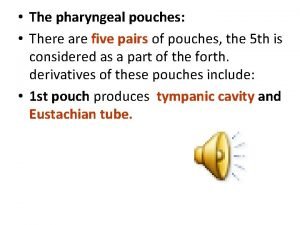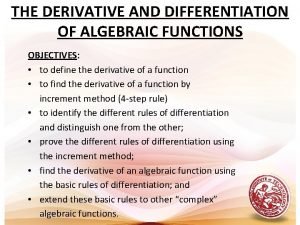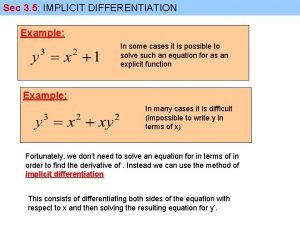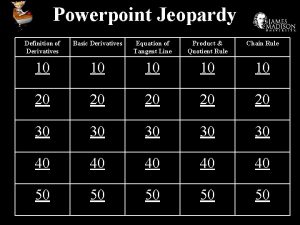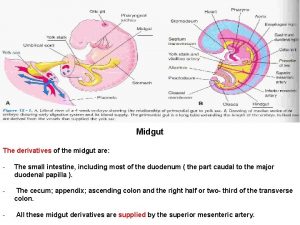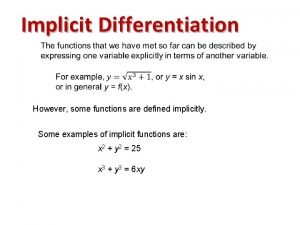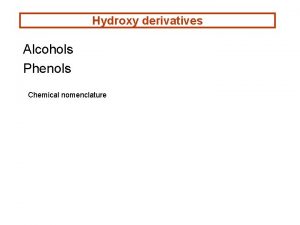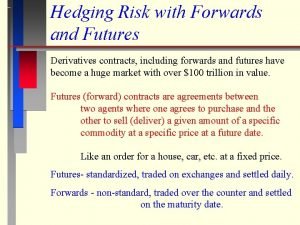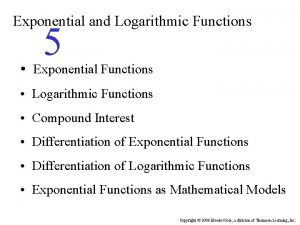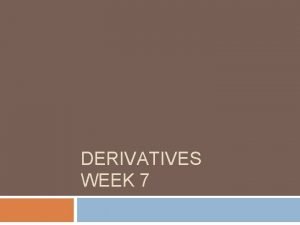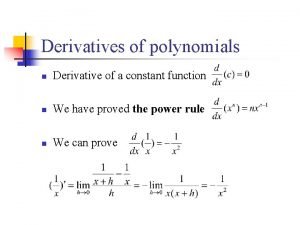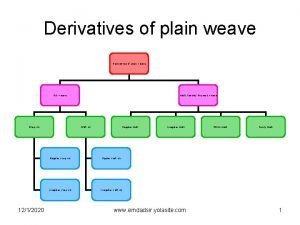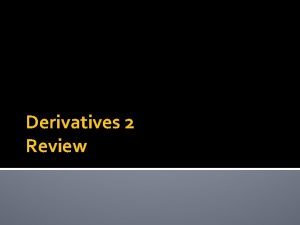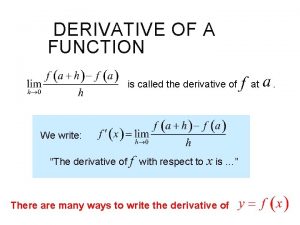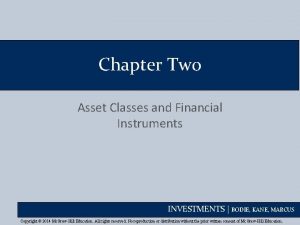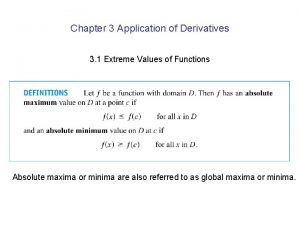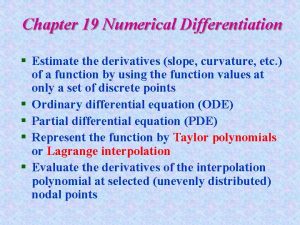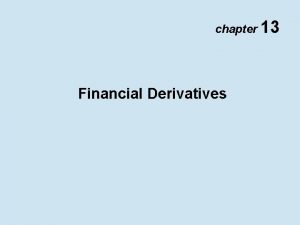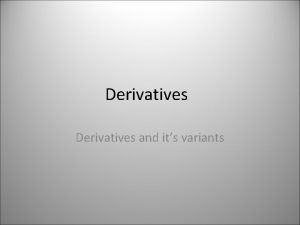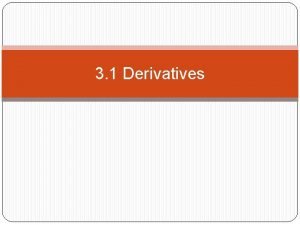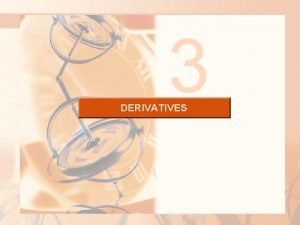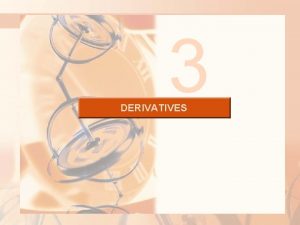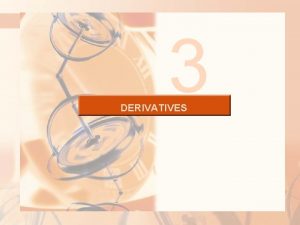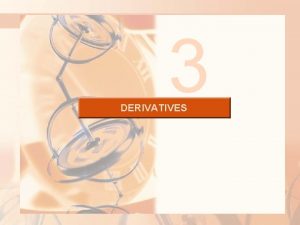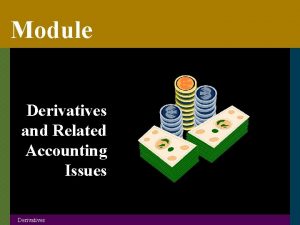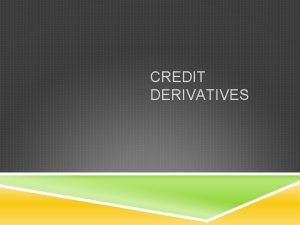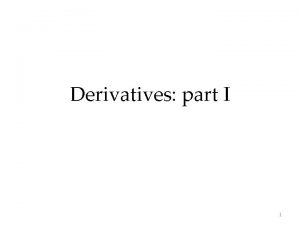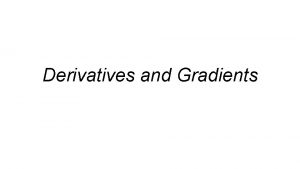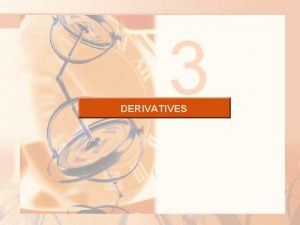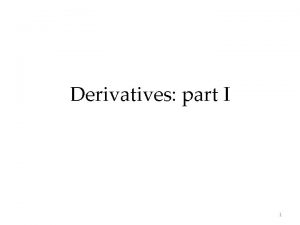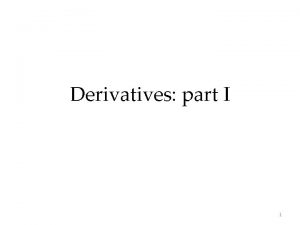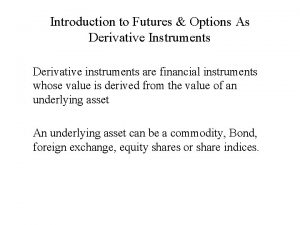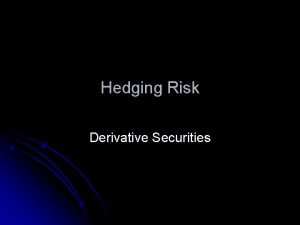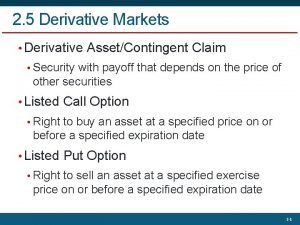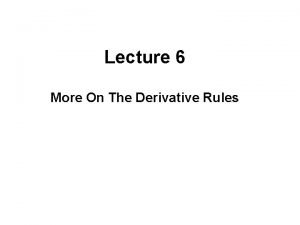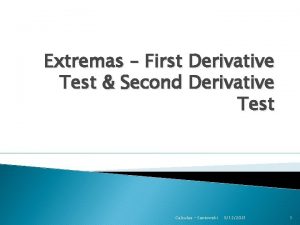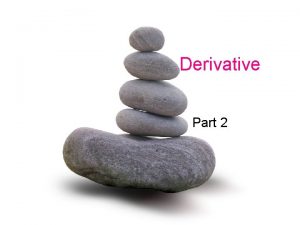Introduction to Derivatives What Is a Derivative Uses

































- Slides: 33

Introduction to Derivatives What Is a Derivative? Uses and Misuses Forwards Futures Options

What Is a Derivative? l Definition l l Types l l An agreement between two parties which has a value determined by the price of something else Options, futures and swaps Uses l l Risk management (hedging risks) Speculation Reduce transaction costs Regulatory arbitrage Investments 21 2

Increased Volatility… l Oil prices: l DM/$ rate: Investments 21 3

…Led to New and Big Markets l Exchange-traded derivatives l Over-the-counter traded derivatives: even more! Investments 21 4

It’s Not What It Is, It’s How You Use It… l Risk management or speculation? l How big a bet can you make with derivatives? l l l What about closer to home? l l l Q: How can one trader bring down the oldest British bank? A: Futures and Options! (see Nick Leeson) Orange County, CA went bankrupt in 1994 When Genius Failed - LTCM debacle in 1998 Avoiding regulations, taxes, and transaction costs – is it always worth it? Investments 21 5

Financial Engineering l The construction of a financial product from other products l New securities can be designed by using existing securities l Financial engineering principles l l Facilitate hedging of existing positions Enable understanding of complex positions Allow for creation of customized products Render regulation less effective Investments 21 6

Forward Contracts l Definition: a binding agreement (obligation) to buy/sell an underlying asset in the future, at a price set today l l A forward contract specifies l l The features and quantity of the asset to be delivered The delivery logistics, such as time, date, and place The price the buyer will pay at the time of delivery Pros: l l Hedges risk by locking in future price Flexible Cons: l l Lack of liquidity: hard to find counterparty Subject to default risk: requires information to screen good from bad risk Today Investments 21 Expiration date 7

Payoff on a Forward Contract l l l Long position = agree to buy securities (commodities) at future date Short position = agree to sell securities (commodities) at future date Payoff for a contract is its value at expiration: l l l Long forward = Spot price at expiration – Forward price Short forward = Forward price – Spot price at expiration Example 2. 1: S&R (special and rich) index: l l Today: Spot price = $1, 000, 6 -month forward price = $1, 020 In six months at contract expiration: Spot price = $1, 050 l l Investments 21 Long position payoff = $1, 050 – $1, 020 = $30 Short position payoff = $1, 020 – $1, 050 = ($30) 8

Payoff Diagram for Forwards l Long and short forward positions on the S&R 500 index Investments 21 9

Futures Markets l Financial Futures Contract l l l Futures are just standardized forward contracts that are traded on exchanges At expiration date, price of contract = price of the underlying asset delivered Prior to the expiration date, it is easily prices using the “cash and carry” approach Exchanges: CBOE, CME, etc. Regulated by CFTC (Commodity Futures Trading Comission) Success of Futures Over Forwards l l Futures more liquid: standardized, can be traded again, delivery of range of securities Mark to market and margin requirements: avoids default risk Anybody can write (issue) futures and options Flexible types of settlement l l Cash settlement by netting: less costly and more practical Physical delivery: often avoided due to significant costs Investments 21 10

Options - Introduction l Definition l l Option is a right to buy or sell an underlying asset at a specified price on or before a specified date Key Elements l l Specified Price: Exercise or Strike Price Specified date: Expiration date l l l Exercise only on expiration date: European Option Exercise on or before expiration: American Option Premium or Price: the price of the option Call: Right to buy Put: Right to sell Investments 21 11

Options - Introduction l l Example: on 11/29/2005, MSFT Jan 27 Call trades at $1. 20; MSFT stock price is $27. 68 What does it tell us? l l l l Style: American Call Underlying Security: MSFT Stock Strike Price: $27 Expiration Month: Jan, 2006 Expiration Date: The 3 rd Friday Current asset price: $27. 68 Call price (premium): $1. 20 Investments 21 12

Option Values l Option Creation and Exercise: l 11/29/2005: 1 contract of MSFT Jan 27 call created Pay Option Premium = $1. 20 x 100 Option Buyer (Long position) l MSFT Jan 27 Call Option Seller (Short position) 1/20/2006 or before: buyer exercises call Pay $27 x 100 Option Buyer (Long position) l 100 shares of MSFT stock Option Seller (Short position) When to exercise? l l Investments 21 Decision: exercise if St > $27 Payoff per share: St - $27 13

Option Values l Moneyness l In-the-money (ITM): positive payoff for immediate exercise l l l At-the-money (ATM): zero payoff for immediate exercise l l For call: St – X > 0 For put: St – X < 0 For both call and put: St – X = 0 Out-of-the-money (OTM): negative payoff for immediate exercise l l For call: St – X < 0 For put: St – X > 0 Investments 21 14

Option Values l Example: If current MSFT stock price $27 l Option 1: Jan 25 MSFT call l l Option 2: Jan 27 MSFT call l l at-the-money call Option 3: Jan 30 MSFT call l l in-the-money call out-of-the-money call Option 4: Jan 30 MSFT put l in-the-money put Investments 21 15

Option Values l Payoff versus P/L (Profit/Loss) l Notation l l l Security Price: St Strike (Exercise) Price: X Payoff per share at expiration for a call l Payoff = max(ST – X, 0) § § l Payoff = ST –X if ST > X or the option is in-the-money Payoff = 0 if ST < X or the option is out-of-the-money Profit or loss l Investments 21 P/L = Payoff – Option Premium 16

Option Values l l MSFT Jan 27 call trading at $1. 20 Decision Time: 1/20/2006 Possible Price of MSFT on 1/20/06 ST - X (X = $27) Exercise Decision $25 $26 $27 $28 $29 $25 -$27 < 0 $26 -$27 < 0 $27 -$27 = 0 $28 -$27 > 0 $29 -$27 > 0 No Exercise Exercise Investments 21 Option Payoff P/L 0 0 0 $1 $2 -1. 20 -0. 20 0. 80 17

Option Values l Payoff Diagram of MSFT Jan 27 Call Payoff of A Call Option Value P/L ITM Region OTM Region 0 -$1. 20 (Premium) Investments 21 X = $27 ST MSFT price at T 18

Option Value l Leverage Effect of a Call l l MSFT price $20; MSFT Jan 20 ATM call price $4 Start with $1, 000 in the account Strategy 1 (all equity): buy 50 shares of MSFT Strategy 2 (all option): buy 2. 5 contract* call ST $30 $10 Strategy 1 Gain at T Return 50*10 50% 50*(-10) -50% Return Strategy 2 Gain at T 2. 5*100*6 2. 5*100*(-4) 150% -100% Options magnify both gains and losses * for 100 shares each Investments 21 19

Option Value l Payoff Diagram for MSFT Jan 27 Put Value $27 Payoff of Puts at T: = X - ST if ST < X = 0 if ST > X Payoff P/L 0 X = $27 ITM Region OTM Region ST MSFT Price at T -$0. 30 Investments 21 20

Option Strategy l Building Blocks: Call and long stock Payoff at T long call - premium -$1. 20 X=27 ST Payoff at T long stock at $27 stock - $27 Payoff at T X=27 $1. 20 ST -$27 X ST short a call + premium short call Investments 21 21

Option Strategy l Building Blocks: put and short stock long a put X ST short a stock at 27 X ST short a put X Investments 21 ST 22

Option Strategy l Protective Put l l Long stock + Long put Pay put premium for downside protection Long a stock X ST Protective put X X X Long a put X Investments 21 ST ST 23

Option Strategy l Covered Call l l Long stock + short call Sacrifice upside potential for call premium Payoff at T Write a call X ST X Keep the Stock Sell the stock for X Payoff at T Long a stock at X X Investments 21 X ST ST 24

Example – BXM Index l l Covered Index Strategy BXM – CBOE Buy-Write Monthly Index l l l Introduced in 2002 Long S&P 500 Index Exposure Short at-the-money 1 -month call option on the S&P 500 Rebalance monthly on expiration Friday Idea: ATM S&P 500 call options are relatively overpriced Investments 21 25

BXM Index Performance l In 1990 – 2004: S&P 500 BXM l Annual Return (%) Annual Risk (%) 10. 94 14. 65 11. 34 9. 92 Recent developments: l l PBP ETF HVPW ETF Investments 21 26

Option Strategy l Vertical Spread l l Long call with strike X 1 and short a call with X 2 Limited up- and down-side P/L Payoff at T Long Jan 27 call X 1=27 X 2=30 Bullish Spread X 2 > X 1 X 2 - X 1 ST X 1 X 2 X 1 ST ST Short Jan 30 call X 1 Investments 21 X 2 ST X 2 - X 1 Bearish Spread X 2 < X 1 27

Option Strategy l Straddle l l Long a call and a put with the same strike price Benefit from big jumps in stock prices Payoff at T Long Jan 30 call X=30 ST X Long Jan 30 Put X Investments 21 Straddle X X ST ST 28

Variations l Index Options l l Futures Options l l Options on futures: e. g. put on gold futures Foreign Currency Options l l Options on index level: e. g. call on S&P 500, NASDAQ 100, etc. Options on foreign currency: e. g. call on Euro Interest Rate Options l Options on interest rate: e. g. Interest rate caps as call option on LIBOR rate Investments 21 29

Other Options l Warrants l l Bermudan Options l l Essentially call options issued by a firm Discrete time multiple exercises Asian Options l Payoff based on average price Investments 21 30

Option Pricing and Volatility l Options price uncertainty (or volatility)! l Example: Call Option Prices Option price prior to expiration Investments 21 Option price at expiration 31

Implied vs. Realized Volatility l Which one is more useful? Investments 21 32

Wrap-up l l l Futures markets – hedging or speculation? What is an option? Why do we need options? What are the common investment strategies involving options? What is in the price of an option, and what it tells us about the underlying security? How big a bet can you make with derivatives? l Can one trader bring down a bank? Investments 21 33
 3 4 pharyngeal pouch
3 4 pharyngeal pouch How to differentiate algebraic functions
How to differentiate algebraic functions Trigonometric identities derivatives
Trigonometric identities derivatives What is the principal method used to thicken tomato sauce
What is the principal method used to thicken tomato sauce Basic derivatives
Basic derivatives Pharyngeal arches diagram
Pharyngeal arches diagram Pharyngeal arches
Pharyngeal arches Least reactive carboxylic acid derivatives
Least reactive carboxylic acid derivatives Mesoderm
Mesoderm Foregut, midgut hindgut derivatives
Foregut, midgut hindgut derivatives Implicit differentiation matlab
Implicit differentiation matlab Hydroxy derivative
Hydroxy derivative Parietal mesoderm
Parietal mesoderm Higher order derivatives
Higher order derivatives Hedging in forward market
Hedging in forward market Dermatomyotom
Dermatomyotom Log and exponential
Log and exponential Vitelline vein derivatives
Vitelline vein derivatives Veins
Veins What are the underlying assets in derivatives
What are the underlying assets in derivatives Blue chip derivatives
Blue chip derivatives What is the derivative of a constant
What is the derivative of a constant Warp rib weave fabric
Warp rib weave fabric Derivative of inverse function
Derivative of inverse function Derivative of arctan x
Derivative of arctan x Derivatives 2
Derivatives 2 Derivative of the function
Derivative of the function Derivatives asset class
Derivatives asset class Hyperbolic functions derivatives
Hyperbolic functions derivatives Finite divided difference
Finite divided difference Carboxylic acid derivatives
Carboxylic acid derivatives Advantages and disadvantages of derivatives
Advantages and disadvantages of derivatives Carboxylic acids and their derivatives
Carboxylic acids and their derivatives How to name carboxylic acids
How to name carboxylic acids
